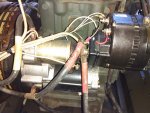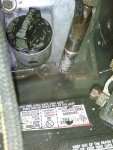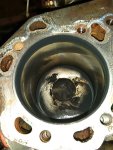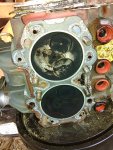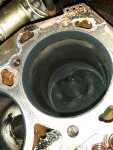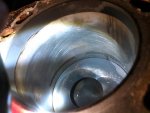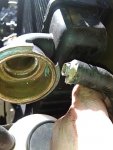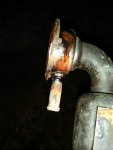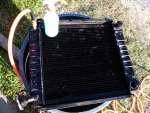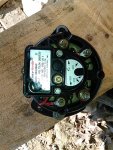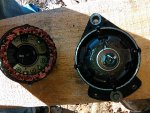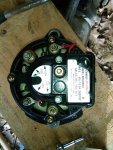Korgoth,
Since you are looking into your set deeper then skin deep at this time, here iare some observations on the fuel tank of the MEP 802 and 803. The tank is where it all starts. Good clean fuel, much less trouble with the engine. The big difference between you and the Army is that the Army uses JP-8. It is a much more “aggressive” fuel. Much harder on rubber or synthetic parts. More on that later.
A good way to start “looking” into the corners is to remove the front cover, figure 6, item 18. Take a gander inside. Often you will find that the fuel float switch, figure 17, item 10 has been “modified”. By that I mean the plug, figure 17, item 6 has been replaced by simply cutting a plug off an old switch and grafting it on the new switch with crimp connectors. Ugly, prone to come apart, but works. Most the time. This switch drove the military and all honest generator repair personnel crazy for YEARS. I heard that it was to be “upgraded”, but the LAR who told me that also rolled his eyes.
I will list the problems with this switch.
- JP-8 tended to “eat” the float material away. Then the magnets (needed to open and close contacts FL-1 and FL-2) embedded in the floats dropped out to collect in the bottom of the tank. With all the other junk.
- The contacts, (FL-1 and FL2) in the switch stem often burnt due to vibrations. The floats jumping up and down a million time an hour, opening and closing the contacts is not good. They burnt open, no contact, or welded closed, continues contact. Not good. More to that also later.
- The replacement plugs and pins were unobtainable for years. Hence the “modifications”. When at long last pins and plugs became available, the special tools needed to install or remove them were unobtainable.
- The wires from the plug to switch were thin and easy to damage.
- The gasket was often lost, damaged or made of TM covers. So the old RTV tube came out. More to that later.
- The locking nut, used to raise or lower the float switch in the tank often was loose of maladjusted. If the switch was set to low in the tank, vibrations often caused the contacts (FL-1) to open, causing the set to shut down for low fuel, even when the tank was full. Or contacts FL-2, to turn on the low fuel light on the fault indicator. If the switch is to high in the tank, the set shutdown for low fuel, with half a tank. Or even better, the FL-2 contacts also turn on the aux. electric fuel pump when the S-1 Start/Run switch is in the in the aux fuel run position. This often led to fuel pouring out of the fuel tank filler neck, from the fuel tank cap. The cap is vented, to keep pressure in the tank equal to outside air pressure. If the vent is closed or much more often the case, plugged with rust and dirt, the set will stop running, for no fuel.
Here a few words to the fuel tank level switch, figure 17, item 4. It was also something that drove people crazy for years. Mostly the arm, holding the float bulb would get loose and give false readings. Then it would fall off. I once found four floats in a fuel tank. The float goes up and down, moving a wiper arm across a coil. The increase or decrease of resistance is what moves the fuel level meter, M-5, figure 10, item 7. This coil often burnt/shorted out. This switch can also be adjusted for depth in the tank, but I have never seen the need to. Right out of the box, it worked just Jim Dandy.
RTV. A wonderful invention. But not every RTV is friendly to fuel systems. Use one that is compatible to diesel if you JUST HAVE to use it. DO NOT USE RTV Black. It turns into something like thin silly putty. It even feels nasty in your hand. Plugs the electric fuel pump real well.
Look at figure 6, item 22, plate, hold down. It is there to hold the fuel tank down. If the bottom of the hold down, (the foot) is missing, it can and will eat a hole in your tank. I saw this often in the 2007-2008 time frame. Many companies that were using personal, I won’t call them repair personnel, did shoddy TIER 2 Work both in Germany and Letterkenny, Pa. For some reason, this part was often installed without the foot. Or the whole bracket was missing.
The fuel tank adapters, figure 17, items 41 and 43. These fittings were often bad. I think JP-8 had a lot to do with this problem. The fitting consists of a metal fitting, and a rubber expanding plug. You screw in the fitting, and the fitting pulls up a nut embedded in the rubber plug. Works like a charm. The problem was almost always that someone like me tried to get the fitting just that last little bit tighter. At some point it will tear the rubber. Most the time it’s not a big problem. Until you move the set, if you overfill the tank or have lots of vibrations. Then you will have a problem. Fuel everyplace. So get it snug, but not real tight. It should not turn when you try to twist it in the tank, that’s good enough. And don’t forget the washer, item 42. It not going to seal right without it.
You can, if your forearms are not like Charles Atlas, stick your arm into the fuel filler neck and operate the fuel level sender and fuel level switch. Good way to see if things work, and you do not have to take everything apart. At the same time you can look for ugliness. By that I mean slimy stuff, sand, dirt, crap, fuel floats and dead things. Should you find that it’s not real clean, I would suggest pulling the tank. A lot of work. If you do, just pull the top cover, disconnect the radiator hoses and take out all the screws on the skid base. Disconnect all wires and hoses. Lift it up and you have the tank where you need it. Yes, I left out a “few” other things. But you will get the idea if you have to do it.
This was long, but if it helps you or anyone else, that’s good.
